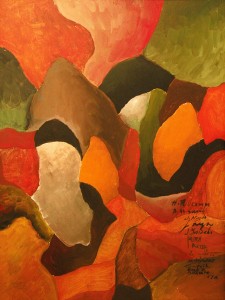A Taza de Oro reunion with H.R. Ocampo
By Cristina DC PastorOn a gloomy overcast morning, H.R. Ocampo’s abstracts gazed at a street digging on W 20th, with Malang’s screen print and Bencab’s etching seemingly keeping them company.
How the Taza de Oro masters got together at the MH Art and Framing Gallery off Fifth Avenue, credit goes to one of its earlier disciples, artist Joan Sommers.
Taza de Oro was a group of artists who met every Saturday at an Ermita coffee shop along Roxas Boulevard in the ‘60s and ‘70s. The painters deferred to peer-mentor modernist H.R. Ocampo, who became their unofficial leader. TdO acquired a revered reputation as a place to be if you wanted to learn to paint from the masters, meet H.R. and his followers, or just be part of Manila’s lively art scene. Over the years, the coffee club grew into a movement as the younger artists adopted various art traditions and philosophies but always hewing close to Ocampo’s purity of artistic expression.
Joan, then a young graduate of the Chicago Art Institute, began joining the painters for weekly sketching sessions and became friends with many of them.
“She became part of the Saturday group,” Joan’s daughter Daria recalled in an interview with The FilAm. “She had heard about it and she went and she showed up. At the time she had already done a lot of work and a lot of shows. They invited her and they respected her ability and she became a member.”
The ongoing exhibit (till November 19) at the MH Gallery, entitled “Across Generations: Modernism in 20th & 21st Century Southeast Asian Art,” is a showing of Joan’s private collection acquired when she was traveling around Southeast Asia and getting to know the region’s noted post-war artists – H.R. Ocampo, Mochtar Apin of Indonesia, Chalood Nimsamer of Thailand and their protégés.
The exhibit is a “small, yet important, mosaic” within the larger tapestry of Southeast Asian art, said Nick Rosal, owner of MH Gallery.“We’re talking about paintings of more than 30 years ago as seen through Joan Sommers’ eyes. These are art work beautiful enough to collect,” he said.
Daria said her mother enjoyed her time hanging out with the Saturday Group.
“She’s very close with Ocampo. She was good friends with Cesar Legaspi and Bencab. She would say, ‘Wow these are the people I wanna be with, very interesting people. I feel like I’m in a good place here,’” said Daria.She described her mother’s collection as “art that has its own integrity.”
“A lot of it was post-World War II, and from a New York or western (curator’s) point of view you look at them as being about the past,” she explained. “What’s so vibrant about it is the idea that when you go to these countries, they look at the artists’ work in the present.”
Nick, a Filipino who was born in Canada but grew up in Brooklyn, confessed to being “guilty of not being aware” of who the artists were until Joan told him the Taza de Oro art scene.
“That’s the beauty of art,” said Nick, a graphic design and advertising graduate of Pratt Institute. “Artists don’t look at the flag. They just look at the art. Joan happened to be in places where there was art to appreciate.”
Although the paintings meant so much to her, Joan did not think of herself as a serious collector.
“It meant an enormous amount to her,” said Daria. “But she thinks of herself as a western artist and she had the ability to find this art. It’s kind of a visual sustenance to her. She’s trying to help find them a good home.”
When he saw the Philippine art in Joan’s collection, Nick said he saw “something very very personal.” As he came to know more about the artists, their styles and their accomplishments, he said, “What ended up on our wall is something of historical significance.”
Cristina DC Pastor is the founding editor of The FilAm.














